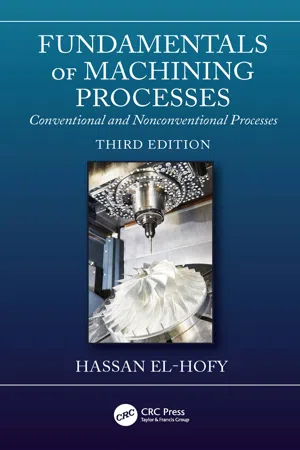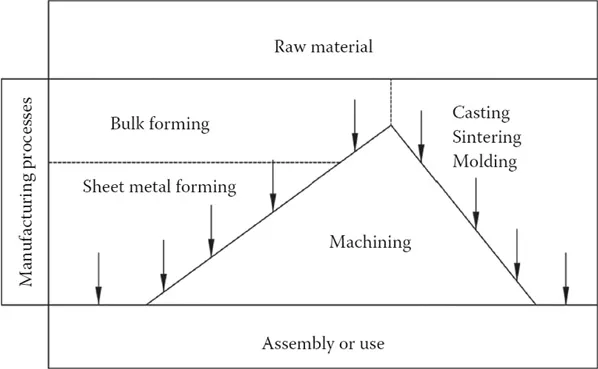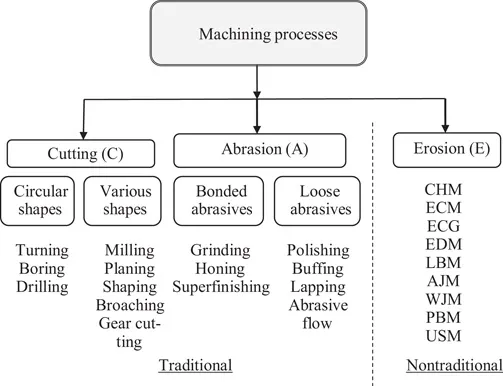
eBook - ePub
Fundamentals of Machining Processes
Conventional and Nonconventional Processes, Third Edition
This is a test
- 556 pages
- English
- ePUB (mobile friendly)
- Available on iOS & Android
eBook - ePub
Fundamentals of Machining Processes
Conventional and Nonconventional Processes, Third Edition
Book details
Book preview
Table of contents
Citations
About This Book
Written by an expert with over 40 years of experience in research and teaching machining and related topics, this new edition textbook presents the principles and theories of material removal and applications for conventional, nonconventional and hybrid machining processes. The new edition is ideal for undergraduate students in production, materials, industrial, mechatronics, marine, mechanical, and manufacturing engineering programs, and also useful for graduate programs related to higher-level machining topics, as well as professional engineers and technicians. All chapters are updated, with additional chapters covering new topics of composite machining, vibration assisted machining and mass finishing operations.
Features
-
- Presents a wide spectrum of metal cutting, abrasive machining, nonconventional and hybrid machining processes
- Analyzes the chip formation in machining by cutting and abrasion processes as well as the material removal mechanisms in the nonconventional and the hybrid processes
- Explains the role of each process variables on its behavior and technological characteristics in terms of material removal, product accuracy and surface quality
- Portrays the theoretical and empirical formula for removal rates and surface finish in different processes as well as very useful technical data that help in solving and analysis of day-to-day shop floor problems that face manufacturing engineers
- Clarifies the machinability concept and introduces the general guidelines for machining process selection
Frequently asked questions
At the moment all of our mobile-responsive ePub books are available to download via the app. Most of our PDFs are also available to download and we're working on making the final remaining ones downloadable now. Learn more here.
Both plans give you full access to the library and all of Perlego’s features. The only differences are the price and subscription period: With the annual plan you’ll save around 30% compared to 12 months on the monthly plan.
We are an online textbook subscription service, where you can get access to an entire online library for less than the price of a single book per month. With over 1 million books across 1000+ topics, we’ve got you covered! Learn more here.
Look out for the read-aloud symbol on your next book to see if you can listen to it. The read-aloud tool reads text aloud for you, highlighting the text as it is being read. You can pause it, speed it up and slow it down. Learn more here.
Yes, you can access Fundamentals of Machining Processes by Hassan El-Hofy in PDF and/or ePUB format, as well as other popular books in Ciencias físicas & Mecánica. We have over one million books available in our catalogue for you to explore.
Information
1
Machining Processes
1.1 INTRODUCTION
Many manufactured products require machining at some stage of their production sequence. Machining is the removal of unwanted materials (machining allowance) from the workpiece so as to obtain a finished product of the desired size, shape, and surface quality. Generally, machining ranges from relatively rough cleaning of castings to high-precision micromachining of mechanical components that require narrow tolerances.
The removal of the machining allowance through cutting techniques was first adopted using simple handheld tools made from bone, stick, or stone that were replaced by bronze or iron. Water, steam, and, later, electricity were used to drive such tools in the power-driven metal-cutting machines (machine tools). The development of new tool materials opened a new era to the machining industry where machine tool development took place. Nontraditional machining techniques offered alternative methods for machining parts of complex shapes in harder, stronger, and tougher materials that were difficult to cut by the traditional methods.
Machining is characterized by its versatility and capability of achieving the highest accuracy and surface quality in the most economic way. The versatility of machining processes can be attributed to many factors, some of which are
- The process does not require elaborate tooling.
- It can be employed to all engineering materials.
- Tool wear is kept within limits, and the tool is not costly.
- The large number of machining parameters can be suitably controlled to overcome technical and economic difficulties.
Machining is generally used as a final finishing operation for parts produced by casting and forming before they are ready for assembly or use (Figure 1.1). However, there are a number of reasons that make machining processes an obligatory solution as compared with other manufacturing techniques. These are
- If closer dimensional control and tighter tolerances are required than are available by casting and forming.
- If special surface quality is required for proper functioning of a part.
- If the part has external and internal geometric features that cannot be produced by other manufacturing operations.
- If it is more economical to machine the part than to produce it by other manufacturing operations.
Micromachining has become an important issue for machining three dimensional (3D) shapes and structures as well as devices with dimensions in the order of micrometers. Furthermore, in nanomachining, atoms or molecules (rather than chips) are removed to produce parts for the microelectronics, automobile, and aircraft manufacturing industries.

FIGURE 1.1 Manufacturing processes.
1.2 HISTORICAL BACKGROUND
The development of metal-cutting machines, usually called machine tools, started from the invention of the cylinder that was changed to a roller guided by a journal. The ancient Egyptians used these rollers for transporting the required stones from quarries to building sites. The use of rollers initiated the introduction of the first wooden drilling machine that dates back to 4000 BC. In such a machine, a pointed flint stone tip acted as a tool. The first deep-hole boring machine was built by Leonardo da Vinci (1452–1519). In 1840, the first turning machine was introduced. Maudslay (1771–1831) added the lead screw, back gears, and the tool post to the previous design. Later, slideways for the tailstock and automatic tool-feeding systems were incorporated. Planers and shapers have evolved and were modified by Sellers (1824–1905). In 1818, Whitney built the first milling machine. The cylindrical grinding machine was built for the first time by Brown and Sharp in 1874. Fellows’ first gear shaper was introduced in 1896. In 1879, Pfauter invented the gear hobbing, while the gear planers of Sunderland were developed in 1908.
Further developments for these conventional machines came by the introduction of the copying techniques, cams, and automatic mechanisms that reduced the labor and work and consequently raised the product accuracy. In 1953, the introduction of the numerical control (NC) technology opened wide doors to the computer numerical control (CNC) and direct numerical control (DNC) machining centers that enhanced the product accuracy and uniformity. Machine tools form around 70% of the operating production machines and are characterized by their high production accuracy compared to the metal-forming machine tools.
Machining has been the object of considerable research and experimentation that has led to better understanding of the nature of the machining processes and improvements to the quality of the machined parts. Systematic research began in 1850 and has ever since continued to cover the following topics:
- 1851—measurements of the cutting forces and power consumption to remove a given volume of metal
- 1870—mechanics of chip formation
- 1893—analysis of forces in the cutting zone
- 1907—study of tool wear and the introduction of high-speed steel (HSS)
- 1928—machinability terms and definitions
- 1935—introduction of the theoretical models of orthogonal and oblique cutting
- 1950—verification of the metal-cutting models
- 1960—developments in the field of grinding and nontraditional machining processes
- 1970—developments in the field of nontraditional and hybrid machining processes, including micromachining and nanomachining
1.3 CLASSIFICATION OF MACHINING PROCESSES
Traditional machining requires a tool that is harder than the workpiece that is to be machined. This tool penetrates the workpiece for a certain depth of cut. A relative motion between the tool and workpiece is responsible for the form and generation cutting to produce the required shapes, dimensions, and surface quality. Such a machining arrangement includes all machining by cutting and mechanical abrasion (MA) processes. The absence of tool hardness or contact with the workpiece makes the process nontraditional, such as the erosion processes by electrochemical and thermal machining methods (see Figure 1.2).

FIGURE 1.2 Classification of machining.
1.3.1 MACHINING BY CUTTING
Figure 1.3 shows the main components of a typical metal-cutting process. The machining system includes the tool, the workpiece, and the machine tool that controls the workpiece and tool motions required for the machining process. Table 1.1 shows the different tool and workpiece motions for some important metal-cutting operations. During machining by cutting, the tool penetrates the workpiece as far as the depth of cut. Cutting tools have a definite number of cutting edges of a known geometry. Moreover, the machining allowance is removed in the form of visible chips. The shape of the produced workpiece depends on the relative motions of the tool and workpiece. In this regard, three different cutting arrangements are possible, as depicted in...
Table of contents
- Cover
- Half Title
- Title Page
- Copyright Page
- Dedication Page
- Table of Contents
- Preface
- Foreword
- Acknowledgments
- Abbreviations
- List of Symbols
- Author
- Chapter 1 Machining Processes
- Chapter 2 Cutting Tools
- Chapter 3 Mechanics of Orthogonal Cutting
- Chapter 4 Tool Wear, Tool Life, and Economics of Metal Cutting
- Chapter 5 Cutting Cylindrical Surfaces
- Chapter 6 Cutting Flat Surfaces
- Chapter 7 High-Speed Machining
- Chapter 8 Machining by Abrasion
- Chapter 9 Abrasive Finishing Processes
- Chapter 10 Modern Abrasive Processes
- Chapter 11 Magnetic Field-Assisted Finishing Processes
- Chapter 12 Mass Finishing Operations
- Chapter 13 Machining by Electrochemical Erosion
- Chapter 14 Machining by Thermal Erosion
- Chapter 15 Hybrid Machining Processes
- Chapter 16 Micromachining
- Chapter 17 Machining Composite Materials
- Chapter 18 Vibration-Assisted Machining
- Chapter 19 Machinability
- Chapter 20 Machining Process Selection
- References
- Index